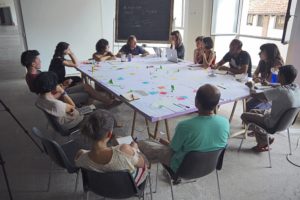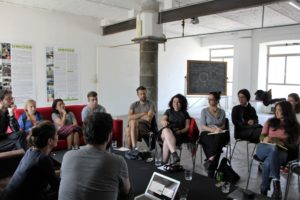My arrival at Cittadellarte is due to 2 things: naturally the 1st was the idea of art as a creative and transformative force of life, not just representation and action on the imagination, which Michelangelo Pistoletto transmitted. The 2nd was the blog of Omi and Teresa (CALC). They told how they had accompanied a village on the coast of Asturias to reclaim the space of a small park in the city center that had become a landfill. The images of the meetings with the inhabitants, the large collective lunches, the orange tree that blossomed and spread with the smell of its fruits the desire to live, the energy of beauty and coexistence… so in May 2000 I crossed the threshold of what would become my home and found myself living immersed in the University of Ideas which that very year was born as a 4-month collective residency program.
One night some time later I woke up thinking about when my university student years, following my investigations in the squatted buildings of Turin, I fantasized about the idea of creating a space where artists and activists intent on changing the world could find refuge and a home; I had called it Casanova, and that night the agitation that woke me up was due to the fact that as a Foundation we had decided to buy the buildings of the wool mill downstream: these buildings were called, from the name of the owner, “Canova”. The coincidence left me with a vague uneasiness.

For me, Unidee has always been the thinking heart and the beating brain of Cittadellarte.
The thousands of people I have met have been for me an Atlas of imaginable worlds. With them I have seen things that not even the replicant in Blade Runner glimpsed. And I have learned to love with wonder and respect what Kandinsky called the inner necessity of art: the difference is that in Unidee this necessity merges with the urgencies of the contexts in which the Unidee residents actually reside. This is why I came to the definition of artivators, “those who activate collective processes through paths, tools, approaches based on art”.
In 2014, after a series of discussions with mentors (in particular Jeanne van Heeswijk and Ana Džokić and Marc Neelen of stealth unilimited), directors of other institutions (in particular Charles Esche), I understood that the format of the UNIDEE residency needed to be rethought. In those years, socially engaged art had become more widespread, dozens (today there are hundreds) of residency programs had been born. The economic status of the artist had become even more precarious, to the point of arriving at the current situation where artists, in order to continue their training or to earn (rarely) a small fee, move from one residency to another, sometimes staying 1 month, sometimes 3 or 6, but they do not really live anywhere. And this takes away their ability to fully operate the social practices of which they are authors, and at the same time takes away from the territories and communities those subjects capable of activating, stimulating, enzymating, unleashing processes of collective co-creation and care. Thus, with a discussion with Juan Sandoval and Armona Pistoletto, we organized what would have consolidated the transition of Unidee to the modular structure currently in force.

We also developed other forms of residency, in particular significant for me are the connective residencies in which the resident connects to an Uffizio of Cittadellarte and brings the lifeblood of his or her own research and vision, often for a 6-month course and various residential modules of 2 or 3 weeks. In this way, in fact, the advantages of the 2 opposite models are obtained, reducing their limits: the long residency is replaced by the continuity in the territory of the Uffizio of Cittadellarte project (for example the Let Eat Bi project coordinated by Armona), while in the artist’s territory of origin she herself remains present except for those short periods of residency in Cittadellarte.
What still needs to happen is a more transformative connection between all the residency paths and the many activities of cittadellarte, with the project of establishing Biella area as a Demopractic Archipelago; with the Unidee Academy structured in 3-year courses and masters; with the Sustainable Fashion Office (for example the CIRCULART project); with Visible, which was born precisely as an extension of the research on what the former students did after the first Unidee decade; and with the over 260 Cittadellarte Embassies in the world. Integrating with porous and collaborative devices the various bodies of Cittadellarte with the communities and territories of its networks, and establishing co-author bodies of an “Interlocal State of the Art” is the backbone of the program for the next 10 years. Together.

